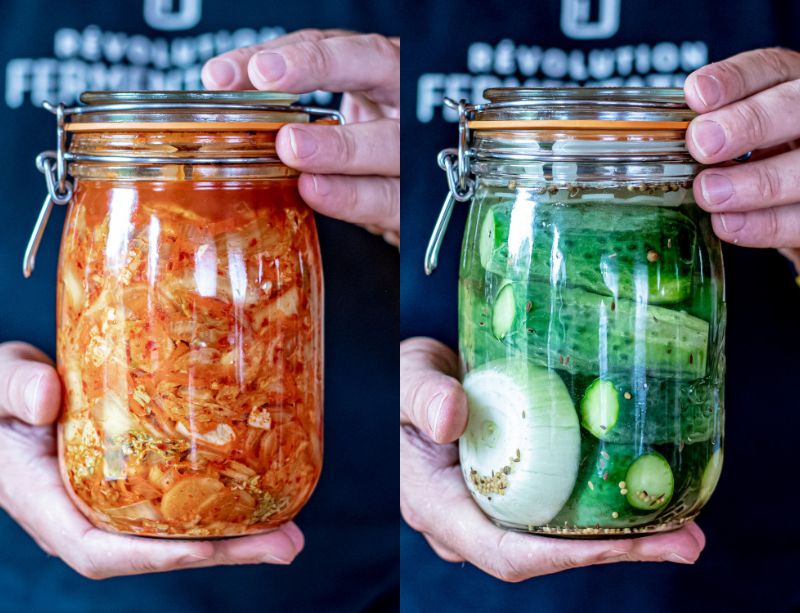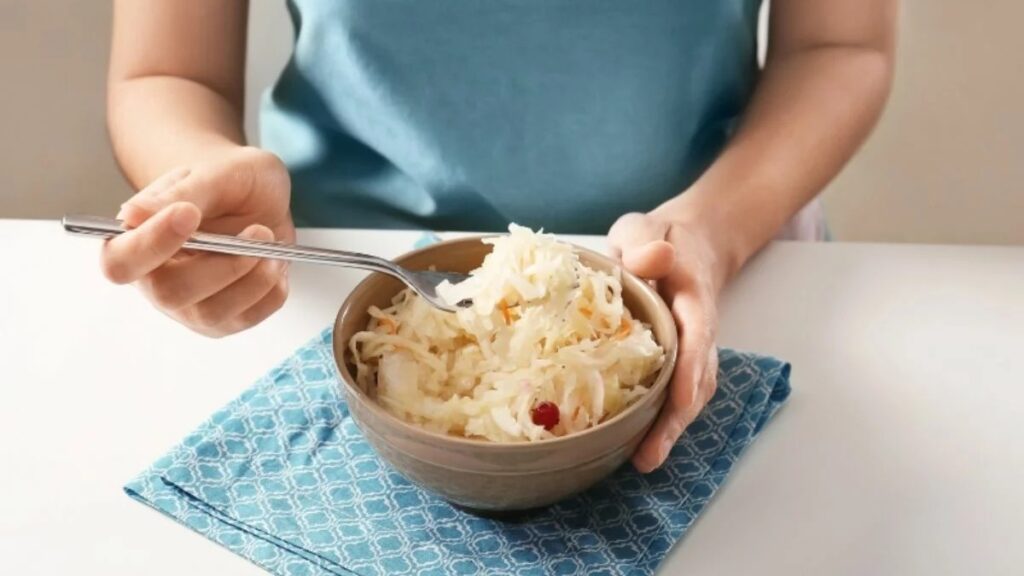Salt is an essential ingredient in all vegetable fermentations (lacto-fermentations).
It helps the fermentation process run smoothly, while contributing to the development of flavour, maintaining the crunchiness of the vegetables, and preserving their health benefits.
Wondering what is the salt ratio for lacto-fermentation? Read on for quick, clear answers!
For everything you need to know about salt in lacto-fermentation, dive into our complete guide Salt and Brine for Fermenting Vegetables (The Ultimate Guide).
Dry Salting or Brine?
Before you can calculate how much salt to add, you first need to know whether you’re going to dry salt (add the salt directly to the vegetables) or use brine (mix the salt with water).

When Should Dry Salting Be Used?
Dry salting (without water) is used when vegetables are:
- cut very finely
- saturated with water
- in a purée, paste, or sauce
In a nutshell, dry salting is used when the vegetables can release enough of their own water to be covered with it.
This technique is used in particular for fermented vegetable recipes such as sauerkraut, kimchi, carrots, and salsa.
When Should Brine Be Used?
A brine (water + salt) is used when the vegetables are:
- Whole
- in large chunks
- only slightly saturated with water
In a nutshell, we choose to use a brine when the vegetables are unable to soak sufficiently to be covered with their own water. We then need to add salt water.
Brine is particularly used for fermented vegetable recipes such as pickles, vegetable sticks, or hot sauces.
How Much Salt to Add?
The percentage of salt used in lacto-fermentation is a matter of taste, the sugar content of the vegetables, and the desired shelf life.
- The less salt, the faster the fermentation.
- The more salt, the crunchier and mould-resistant the vegetables.
Nevertheless, be aware that there is always a minimum percentage of salt to add for fermentation to work properly and be safe!
Percentage of Salt by Vegetable
| Percentage | Ingredient |
|---|---|
| 2% | Garlic, beetroot, broccoli, carrots, celery, cauliflower, cabbage, green beans, corn, potatoes, radishes, tomatoes |
| 3-4% | Cucumbers (pickles), squash, fruit, onions, chili peppers, peppers, Jerusalem artichokes |
| 10% | Olives, umeboshi plums |
At concentrations of less than 2% salt, it is necessary to add a vegetable starter culture and/or calcium chloride to ensure that the fermentation process is not contaminated by pathogens.
Dry Salting
For dry salting of fine cut, crushed, or high water content vegetables, we need to soak them. Remember, we want to obtain enough liquid to submerge them!
Once the vegetables have been cut, salted, and mixed well, leave to soak in a bowl for 15 to 30 minutes. Then pack them tightly in a jar and add a weight to keep them submerged.
The salt to be added for dry salting is calculated based on the weight of the ingredients.
The table below shows the amount of salt to add for dry salting (in grams or by spoonful) according to the desired salt level and the weight of the vegetables.
| Weight of vegetables | 2% salt | 3% salt | 10% salt |
|---|---|---|---|
| 250g | 5 g (1 tsp.) | 7.5 g (1 ½ tsp.) | 25 g (1 ½ tbsp.) |
| 500g | 10 g (2 tsp.) | 15 g (2 ½ tsp.) | 50 g (3 tbsp.) |
| 750g | 15 g (3 tsp.) | 22.5 g (4 tsp.) | 75 g (4 ½ tsp.) |
| 1kg | 20 g (4 tsp.) | 30 g (5 tsp.) | 100 g (6 tbsp.) |
Brine
- Add the ingredients to a jar.
- Then add the salt.
- To finish, add the water to completely cover the vegetables.
In the case of brine, the salt to be added is based on the volume of the jar. In the metric system, the volume is equivalent to the weight. The great advantage of this method is its simplicity, guaranteeing a perfectly adjusted dose of salt for the total weight of the ingredients (vegetables + water).
The table below shows the amount of salt to add for brine (in grams or by the spoonful) according to the desired salt content and the volume of your jar.
| Jar volume | 2% salt | 3% salt | 10% salt |
|---|---|---|---|
| 250 ml | 5 g (1 tsp.) | 7.5 g (1 ½ tsp.) | 25 g (1 ½ tbsp.) |
| 500 ml | 10 g (2 tsp.) | 15 g (2 ½ tsp.) | 50 g (3 tbsp.) |
| 750 ml | 15 g (3 tsp.) | 22.5 g (4 tsp.) | 75 g (4 ½ tbsp.) |
| 1 L | 20 g (4 tsp.) | 30 g (5 tsp.) | 100 g (6 tbsp.) |
| 4 L | 80 g (5 tbsp.) | 120 g (7 tbsp.) | 400 g (23 tbsp.) |
Weight of Salt per Kitchen Utensil?
The following table answers the famous question: How much does a spoonful of salt weigh?
| Utensils | Abbreviation | Salt weight |
|---|---|---|
| 1 teaspoon (Canada) | tsp. | 5,7 g |
| 1 teaspoon (France) | csp. | 5,7 g |
| 1 tablespoon (France, Canada) | tbs. | 17 g |
| 1 tablespoon (Canada) | tbsp. | 17 g |
Frequently Asked Questions
Is Salt Bad for Your Health?
On the contrary, sodium (the ingredient in salt) is essential for life!
The connection is often made between salt and high blood pressure because people with high blood pressure need to watch their salt intake (neither too much nor too little). However, salt consumption does not cause high blood pressure!
In fact, salt consumption in Western countries is generally lower today than it used to be, and it is also below the level in many other parts of the world.
Eating fermented vegetables with salt is not only delicious but also good for your health – and salt is a key contributor here.
Curious to find out more about the benefits of fermented foods? Read our article on The Benefits of Fermentation According to a Pharmacist.
What Happens if I Don’t Add Enough Salt?
Fermentation could work if the equipment is perfectly clean and there is a good quantity of lactic acid bacteria on the vegetables. However, the chances of fermentation going wrong are high, because the role of salt is to protect the good bacteria from the bad ones. To find out more, read: What Is Salt Used For?
Which Salt to Use?
The only ingredient in your salt must be “salt”! It must not have added anticaking agents or iodine.
For more information, see our article Best Salt for Lacto-Fermentation.
What Should I Do if My Fermentation Is Too Salty?
Have you dropped the salt shaker in your sauerkraut recipe (or any other fermentation)? The easiest thing to do is to rinse immediately or add more vegetables until it tastes just right.
The salt content does not decrease during fermentation. If it’s too salty on day 1, it will be just as salty on day 30.
If you realize that your fermentation is too salty when you’re ready to eat it, you can rinse it, but you’ll lose a lot of flavour and nutrients. Another solution is to start a new fermentation by incorporating the old one with an equivalent or greater quantity of fresh vegetables.
Follow the normal lacto-fermentation procedure and allow to ferment for at least a week.
A final option is to consume your over-salted fermentation by adding it to other dishes with little (or no) salt.
It’s That Easy!
It’s important to weigh the ingredients carefully, but you don’t need a scale to weigh the salt. A simple spoon is all you need to add the right amount!
Whether you use fine or coarse salt, small variations in weight will not significantly affect your results. Similarly, you can use different types of salt for your fermentations.
We recommend starting with 2% salt (20g/kg of vegetables), small recipes (250ml jars), and short fermentations (1 week). This will allow you to taste the results quickly and adjust the next recipe if necessary.
Still not daring to take the plunge? Check out our 5 Tips for Successful Fermentations and our 3 Foolproof Recipes to Get Started.

